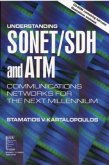"Companies and research labs worldwide are racing to develop Dense Wavelength Division Multiplexing (DWDM) technology, a far-reaching advancement in the fiber optical communications field. To help you keep pace with these latest developments, this all-in-one resource brings you a clear, concise overview of the technology that is transporting and processing vast amounts of information at the speed of light. Until now, no book offered a practical introduction to DWDM advances.
INTRODUCTION TO DWDM TECHNOLOGY will help you learn all the essentials for this emerging field:
_ Principles of physics underlying optical devices
_ Optical components needed to design optical and DWDM systems
_ Coding and decoding techniques used in optical communications
_ Overview of DWDM systems
_ State-of-the-art research trends
Complete with four-color illustrations to show how devices work, this comprehensive book provides an invaluable discussion of DWDM basics necessaryfor practicing electrical engineers, optical systems designers, technical managers, and undergraduate students in optical communications.
Go to
htttp://www.ieee.org/organizations/pubs/press/Kartfm.pdf for a complete Table of Contents and a look at the Introduction. You can check out Chapter 5, ""Optical Demultiplexers"" by clicking on
http://www.ieee.org/organizations/pubs/press/KartCh5.pdf
About the Author
Stamatios V. Kartalopoulos is currently on the staff of the Optical Networks Group of Lucent Technologies, Bell Labs Innovations, formerly known as AT&T. His research interests include ATM and SONET/SDH systems, ultrafast pattern recognition, IP and DWDM, access enterprise systems, local area networks, fiber networks, satellite systems, intelligent signal processing, neural networks, and fuzzy logic. He holds several patents of which six patents (and six pending) are in communications and optical communications systems."
Sponsored by:
IEEE Communications Society
Hinweis: Dieser Artikel kann nur an eine deutsche Lieferadresse ausgeliefert werden.
INTRODUCTION TO DWDM TECHNOLOGY will help you learn all the essentials for this emerging field:
_ Principles of physics underlying optical devices
_ Optical components needed to design optical and DWDM systems
_ Coding and decoding techniques used in optical communications
_ Overview of DWDM systems
_ State-of-the-art research trends
Complete with four-color illustrations to show how devices work, this comprehensive book provides an invaluable discussion of DWDM basics necessaryfor practicing electrical engineers, optical systems designers, technical managers, and undergraduate students in optical communications.
Go to
htttp://www.ieee.org/organizations/pubs/press/Kartfm.pdf for a complete Table of Contents and a look at the Introduction. You can check out Chapter 5, ""Optical Demultiplexers"" by clicking on
http://www.ieee.org/organizations/pubs/press/KartCh5.pdf
About the Author
Stamatios V. Kartalopoulos is currently on the staff of the Optical Networks Group of Lucent Technologies, Bell Labs Innovations, formerly known as AT&T. His research interests include ATM and SONET/SDH systems, ultrafast pattern recognition, IP and DWDM, access enterprise systems, local area networks, fiber networks, satellite systems, intelligent signal processing, neural networks, and fuzzy logic. He holds several patents of which six patents (and six pending) are in communications and optical communications systems."
Sponsored by:
IEEE Communications Society
Hinweis: Dieser Artikel kann nur an eine deutsche Lieferadresse ausgeliefert werden.









